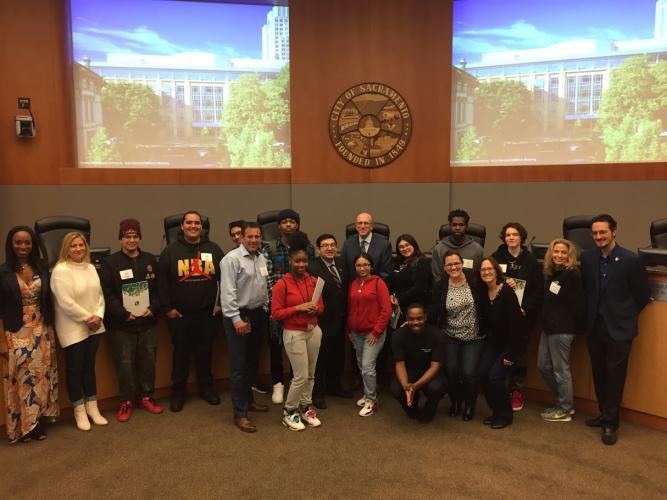Picture Yourself in Local Government
 The Institute for Local Government provides the
revised Picture Yourself in Local Government (PYLG) curriculum to
cities, counties, special districts and educational institutions
to use in classroom and municipal settings to convey essential
information about local government.
The Institute for Local Government provides the
revised Picture Yourself in Local Government (PYLG) curriculum to
cities, counties, special districts and educational institutions
to use in classroom and municipal settings to convey essential
information about local government.
The PYLG curriculum help students learn about the roles, responsibilities and processes of local government. Each separate unit is outlined below; PYLG is also available as a Complete Document.
PYLG’s units include student and class activities to complement the curriculum, thought-provoking questions designed to check student understanding, and a comprehensive vocabulary guide. This curriculum, while primarily designed for high school students, is a resource the can be used for a variety of audiences. PYLG can be useful as:
- Content to include in scripts for student tours of local government offices
- New staff and intern orientation materials that cover local government basics
- Background material for agency staff to use when serving as a guest speaker in a classroom
- Handouts to educate boards, commissions and leadership academies about local government structure and functions
- Easy to understand language tailored for youth and the general public.
Unit 1: Where Did Our Local Governments Come From?
This unit explores the history of local government and the development of cities, counties and special districts in California.
Unit 2: How Are Local Governments Organized?
Local governments in California provide essential services every day. How does a city, county or special district operate to ensure that our community’s needs are met? From how leaders create policy to how administrators and experts implement programs and services, this section discusses who keeps government functioning efficiently.
Unit 3: Who Are The Players In Local Government And How Can You Get Involved?
A variety of experts, including policy-makers, tradespeople, administrators and more provide their talents and time to ensure local governments effectively and efficiently use available resources. This unit explores the roles and responsibilities of the players in local government agencies (cities, counties, special districts and schools).
Unit 4: What Does Local Government Do For Us?
Water, roads, ambulances, airports, courts, schools and fire services. Cities, counties and special districts in the state of California provide all of the essential services that we count on in our daily lives. This section covers what local governments do day-in and day-out to serve communities.
Unit 5: How Do We Pay For Government Services?
Community needs vary and each city, county and special district must have a plan to provide essential services as well as a plan to pay for these essential services and infrastructure. This unit shares information on local government funding policies and practices.
Unit 6: Your Government: You Make the Choices
The five previous units explain the players, the services, the processes and the inner-workings of local government. In this unit, students will develop a new community to call their own and present the information to an audience.
Glossary
The PYLG curriculum highlights key words frequently used in local government. In this glossary, you can find definitions for those words.
Pathways to Public Service: Matching Personal Interests to Local Agency Careers
Cities, counties and special districts could not function without its talented, dedicated public sector workforce. Local government offers people fun and fulfilling careers that have purpose and impact every day. With this printable table, readers can start their pathway to public service based on their personal interests and corresponding careers in local government.
Pathways to Public Service Careers
Acknowledgements & Gratitude to our 2019 PYLG Peer Review Team
The updates to the Picture Yourself in Local Government curriculum would not be possible without the expertise and review from local government professionals throughout California as well as the civics education team at Sacramento County Office of Education. Thank you also to the California Workforce Development Board for their support of promoting pathways to public service careers and this project.
The Institute thanks the following people for their efforts in the 2019 revision to this evergreen resource:
- Dawn Abrahamson, City Clerk, City of Vallejo
- Samantha Argabrite, Deputy City Manager/Public Information Officer, City of Simi Valley
- Ryan Clausnitzer, General Manager, Alameda County Mosquito Abatement District
- Jennifer Connally, CMC, Assistant City Clerk, City of Lake Forest
- Susan M. Domen, MMC, City Clerk, City of Port Hueneme
- Lira Goff, Assistant Agency Clerk/Confidential Administrative Specialist, Sacramento Housing & Redevelopment Agency
- Charley Gilmore, Sacramento County Office of Education
- Brenda Haggard, City Clerk, City of Elk Grove
- Maria Huizar, City Clerk, City of Lake Forest
- Randi Johl, JD, MMC, Director of Legislative Affairs / City Clerk. City of Temecula
- Melissa Kuehne, Communications and Fund Development Manager, Institute for Local Government
- Bina Lefkovitz, Trustee, Sacramento County Office of Education
- June Lemos, CMC, City Clerk, City of Fort Bragg
- Lyanne Mendoza, Human Resources and Risk Management Analyst, City of Loma Linda
- Jenelle Osborne, MayorCity of Lompoc
- Kyle Packham, Advocacy and Public Affairs Director, California Special Districts Association
- Frank Pisi, Sacramento County Office of Education
- Annamarie Porter, CMC, Records Management Supervisor, City of Redondo Beach
- Kristie Ramos, CMC, City Clerk, City of Rancho Mirage
- Mercy Santoro, Deputy Director, Department of Parks and Recreation, County of Los Angeles
- Jerryl Soriano, CMC, City Clerk, City of Desert Hot Springs
- Randi Kay Stephens, Associate Program Manager, Institute for Local Government
- Paul Thompson, Teacher Mira Loma High School
- Linda A. Troyan, City Clerk Services Director, City of Rancho Cucamonga




